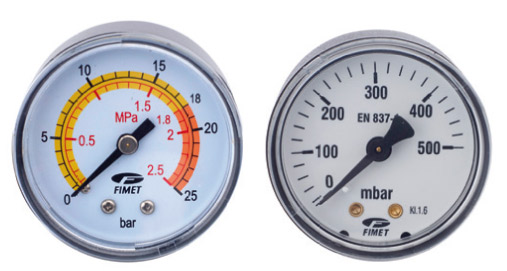The pressure gauge: between history and current events.

What is a pressure gauge?
The term pressure gauge indicates an instrument capable of measuring the pressure difference between two fluids or between two different points of the same fluid. Wanting to be precise, the pressure gauge is the instrument used to measure pressures higher than atmospheric pressure: in fact, to measure lower pressures the most appropriate term is vacuum gauge or vacuum meter.
Historical notes about the pressure gauge
In 1644 Evangelista Torricelli invented the barometer for the first time using what is today called the "Torricelli tube". Subsequently, the studies of the Italian physicist were resumed and improved by Pascal, to whom the unit of measurement of pressure in the International System is also dedicated.
The first pressure gauges, initially, all followed a direct derivation of the barometers: they were U-tubes, with one arm open and one closed, and containing mercury inside. In the twentieth century, technologies based on molecular phenomena were developed for the measurement of deeper voids.
At an industrial level, i.e. in environments where timing cannot necessarily be as long as in a laboratory, the most important pressure gauges became those patented by Bourdon and consisting of a metal tube connected with a pointer. A change in pressure causes a change in the curvature of the tube and, therefore, a shift in the position of the pointer.
The state of the art regarding pressure gauges
There are different types of pressure gauges in the world but all measure the pressure difference between the liquid to be analyzed and the atmospheric pressure at the reference point (in standard conditions and at sea level the value is 101325 Pa, corresponding to 1.01325 Bar). The main ones are:
- U pressure gauges: they consist of a tube filled with a fluid of known density. On the one hand the tube is exposed to atmospheric pressure while on the other it is connected with the measurement environment. The liquid will move to one or the other end to balance the pressure in the environment. The main advantage is that, being a very simple tool, it is not subject to considerable failures. On the other hand, extreme simplicity leads to poor resolution of the instrument.
- Bourdon pressure gauges: they are the most used model today and, as mentioned above, they consist of an elliptical section tube connected to an indicator with a pointer. As the pressure increases, the radius of curvature of the tube will increase causing the pointer to move and signal the pressure variation.
- Membrane pressure gauges: the membrane is the key element and can deform thanks to the difference in pressure between the environment and the atmosphere. In fact, it will tend to swell in the presence of a greater pressure than the measurement environment.
- Piezoelectric pressure gauges: they exploit piezoelectricity, or the property that some materials have of conducting electricity if a pressure difference is applied to them.
In addition to these, as mentioned at the beginning, there are also vacuum gauges for measuring pressures lower than atmospheric.
The first pressure gauges, initially, all followed a direct derivation of the barometers: they were U-tubes, with one arm open and one closed, and containing mercury inside. In the twentieth century, technologies based on molecular phenomena were developed for the measurement of deeper voids.
At an industrial level, i.e. in environments where timing cannot necessarily be as long as in a laboratory, the most important pressure gauges became those patented by Bourdon and consisting of a metal tube connected with a pointer. A change in pressure causes a change in the curvature of the tube and, therefore, a shift in the position of the pointer.
The state of the art regarding pressure gauges
There are different types of pressure gauges in the world but all measure the pressure difference between the liquid to be analyzed and the atmospheric pressure at the reference point (in standard conditions and at sea level the value is 101325 Pa, corresponding to 1.01325 Bar). The main ones are:
- U pressure gauges: they consist of a tube filled with a fluid of known density. On the one hand the tube is exposed to atmospheric pressure while on the other it is connected with the measurement environment. The liquid will move to one or the other end to balance the pressure in the environment. The main advantage is that, being a very simple tool, it is not subject to considerable failures. On the other hand, extreme simplicity leads to poor resolution of the instrument.
- Bourdon pressure gauges: they are the most used model today and, as mentioned above, they consist of an elliptical section tube connected to an indicator with a pointer. As the pressure increases, the radius of curvature of the tube will increase causing the pointer to move and signal the pressure variation.
- Membrane pressure gauges: the membrane is the key element and can deform thanks to the difference in pressure between the environment and the atmosphere. In fact, it will tend to swell in the presence of a greater pressure than the measurement environment.
- Piezoelectric pressure gauges: they exploit piezoelectricity, or the property that some materials have of conducting electricity if a pressure difference is applied to them.
In addition to these, as mentioned at the beginning, there are also vacuum gauges for measuring pressures lower than atmospheric.
24/03/2020
I contenuti di questo sito non hanno carattere di periodicità e non rappresentano 'prodotto editoriale'.








